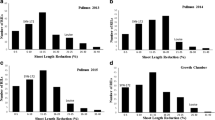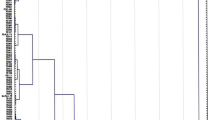Summary
A population of 572 F2 derived F3 lines from six crosses were used to estimate parameters relevant to selection for resistance to Septoria nodorum of wheat. Lines were grown in disease free (fungicide sprayed) and inoculated microplots in 2 replications of a split-plot design in a single environment in 1977. Average yield reduction due to disease was approximately 50%; this was associated with an average septoria score of 50% on the flag leaf, an average septoria score of 42% on the head, and a reduction of 37% in seed weight. Low S. nodorum scores were correlated with late heading date, tall plant height, high grain yield, and high seed weight in diseased plots, and high seed weight % (seed weight in diseased plots expressed as a percentage of seed weight in fungicide sprayed plots).
Restricted selection indexes were used to study the relative contributions of disease escape, true resistance, and tolerance to variability in grain yield in diseased plots, seed weight in diseased plots, and seed weight %. True resistance appeared to be the most important factor causing variation in grain yield in diseased plots and seed weight %. Tolerance and escape seemed to be more important for seed weight in diseased plots.
Heritabilities of S. nodorum scores on the flag leaf and head were 63% and 52%, respectively. Leaf and head scores could be used most effectively as selection criteria to upgrade resistance in a population before harvest.
Selection for high seed weight % slightly reduced yields in disease free plots, although yield in diseased plots and seed weight in diseased plots were increased. However, selection for increased yield or increased seed weight in diseased plots improved yield in disease free plots. It is suggested that direct selection for yield or seed weight in diseased plots is likely to achieve more desirable goals than selection for seed weight %.
Similar content being viewed by others
References
Bockmann, H., H. Mielke & G. Wacholz, 1975. Untersuchungen über die Anfälligkeit verschiedener Winter- und Sommerweizensorten gegen Septoria nodorum Berk. und Fusarium culmorum Link. Z. Pflanzenzücht. 75: 39–47.
Brönniman, A. 1968. Zur Kenntnis von Septoria nodorum Berk., dem Erreger der Spelzenbraune und einer Blattdüre des Weizens. Phytopathol. Z. 61: 101–146.
Brönniman, A., 1975. Beitrag zur Genetik der Toleranz auf Septoria nodorum Berk. bei Weizen (Triticum aestivum). Z. Pflanzenzücht. 75: 138–160.
Doling, D. A., 1958. Glume blotch in wheat varieties. Plant Pathology 10: 24–27.
Eyal, Z., J. F. Brown, J. M. Krupinsky & A. L. Scharen, 1977. The effect of post inoculation periods of leaf wetness on the response of wheat cultivars to infection by Septora nodorum. Phytopathology 67: 874–878.
Eyal, Z. & A. L. Scharen, 1977. A quantitative method for the inoculation of wheat seedlings with pycnidiospores of Septoria nodorum. Phytopathology 67: 712–714.
Frecha, J. H., 1973. The inheritance of resistance to Septoria nodorum in wheat. Bol. Genet. Inst. Fitotec. Castelar 8: 29–30.
Frey, K. J. & T. W. Horner, 1957. Heritability in standard units. Agron. J. 49: 59–62.
Hazel, L. N., 1943. The genetic basis for constructing selection indices. Genetics 28: 476–490.
Hopp, H., 1957. Untersuchungen über die Braunfleckigkeit des Weizens und ihren Erreger Septoria nodorum Berk. (Syn. Macrophoma hennebergii Kuhn). Phytopath. Z. 29: 395–412.
Krupinsky, J. M., J. A. Schillinger & A. L. Scharen, 1972. Resistance in wheat to Septoria nodorum. Crop Sci. 12: 528–530.
Krupinsky, J. M., J. C. Craddock & A. L. Scharen, 1977. Septoria resistance in wheat. Plant Dis. Reptr 61: 632–636.
Laubscher, F. X., Barbara von Wechmar & D. von Schalkwyk, 1966. Heritable resistance of wheat varieties to glume blotch (Septoria nodorum Berk.) Phytopathol. Z. 56: 260–264.
Marchionatto, J. B., 1941. Argentine Republic. An epiphytotic of wheat septoriosis. Int. Bull. Plant Prot. 15: 113–114.
Parlevliet, J., 1977. Plant pathosystems—an attempt to elucidate horizontal resistance. Euphytica 26: 553–556.
Pirson, H., 1960. Prüfung verschiedener Winterweizensorten auf Anfälligkeit gegen Septoria nodorum Berk. mit Hilfe von kunstlichen Infektionen. Phytopath. Z. 37: 330–342.
Robinson, R. A., 1976. Plant pathosystems. Springer-Verlag, Berlin, Heidelberg, and New York, 184 pp.
Scott, P. R. & P. W. Benedikz, 1977. Filed techniques for assessing the reaction of winter wheat cultivars to Septoria nodorum. Ann Appl. Biol. 85: 345–358.
Searle, S. R., 1965. The value of indirect selection I. Mass selection. Biometrics 21: 682–707.
Shipton, W. A., W. J. R. Boyd, A. A. Rosielle & B. L. Shearer, 1971. The common Septoria diseases of wheat. Bot. Rev. 37: 231–262.
Tallis, G. M., 1962. A selection index for optimum genotype. Biometrics 18: 120–122.
Author information
Authors and Affiliations
Rights and permissions
About this article
Cite this article
Rosielle, A.A., Brown, A.G.P. Selection for resistance to Septoria nodorum in wheat. Euphytica 29, 337–346 (1980). https://doi.org/10.1007/BF00025132
Received:
Issue Date:
DOI: https://doi.org/10.1007/BF00025132




